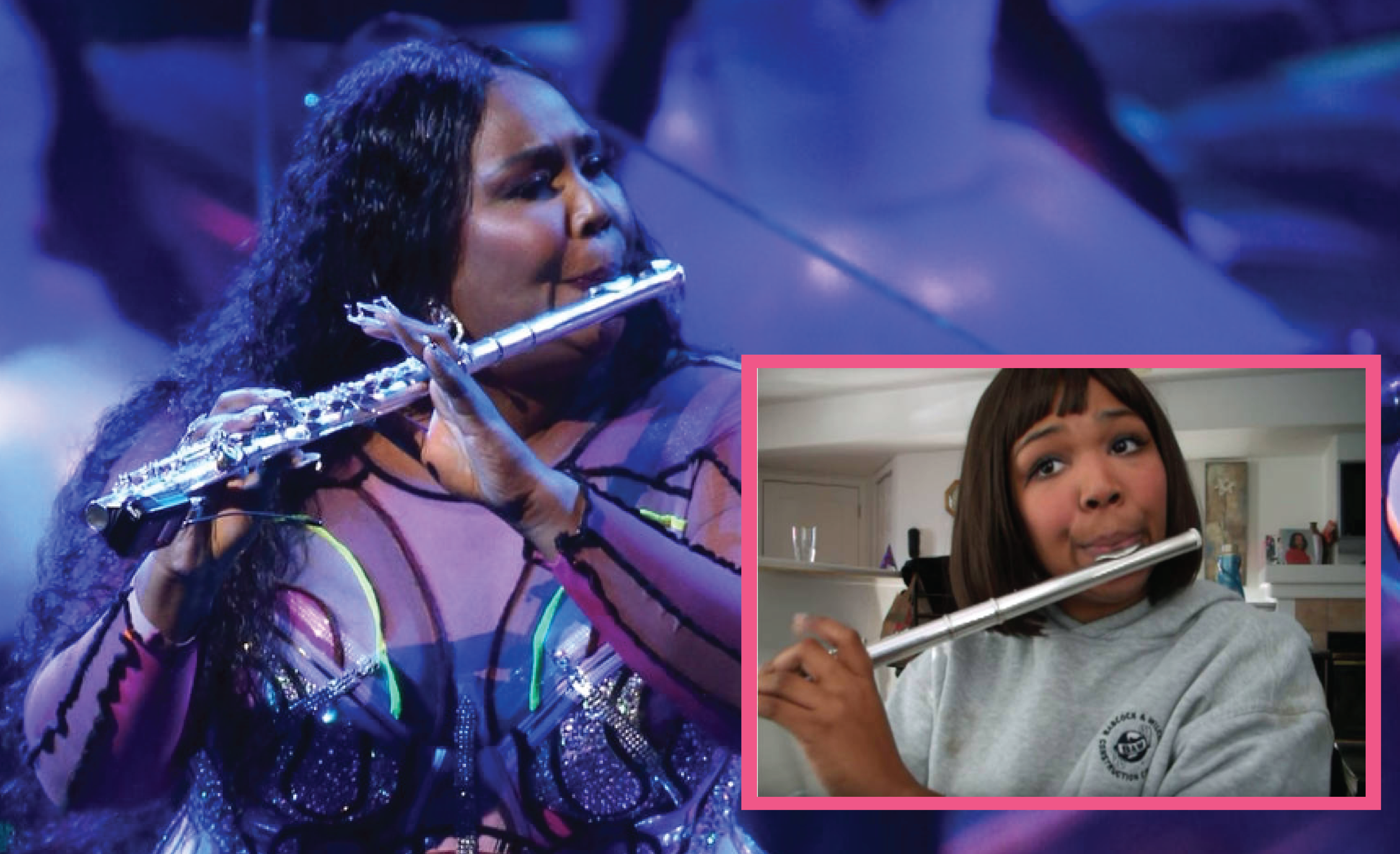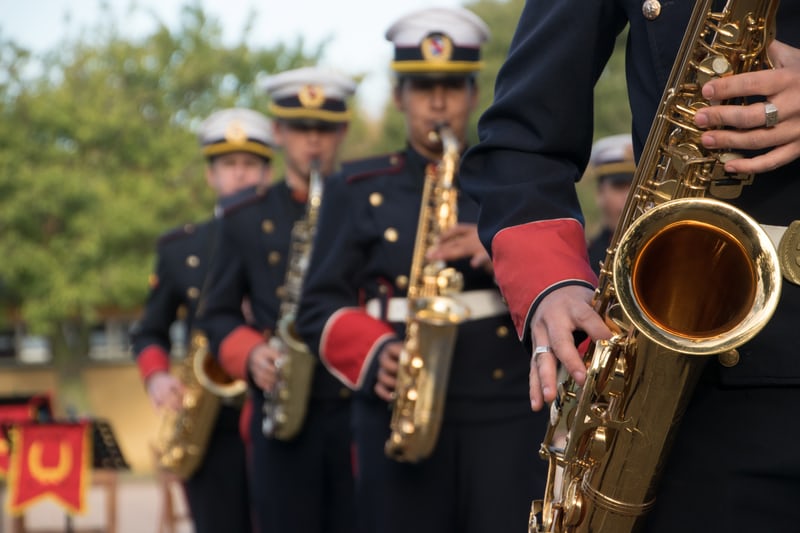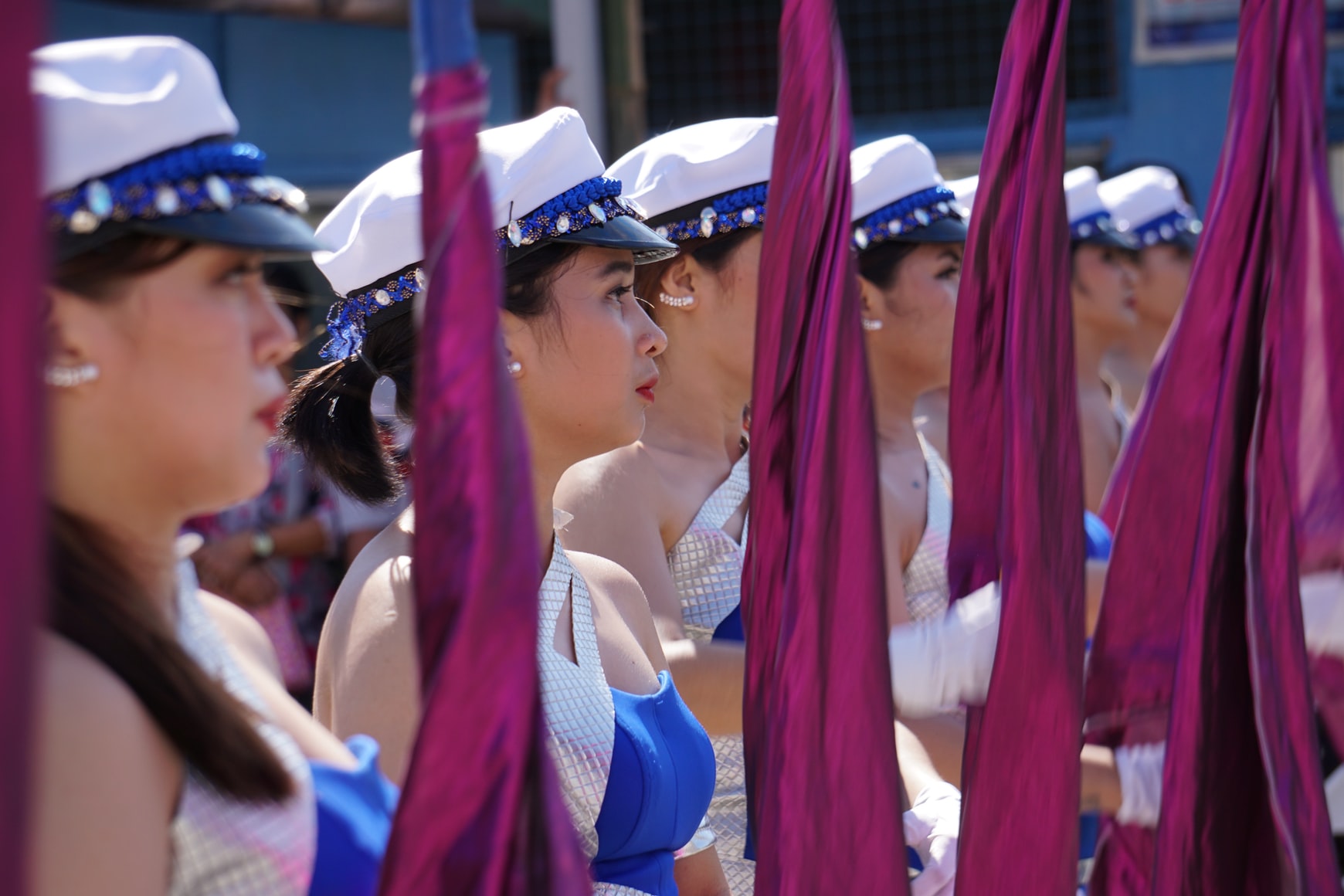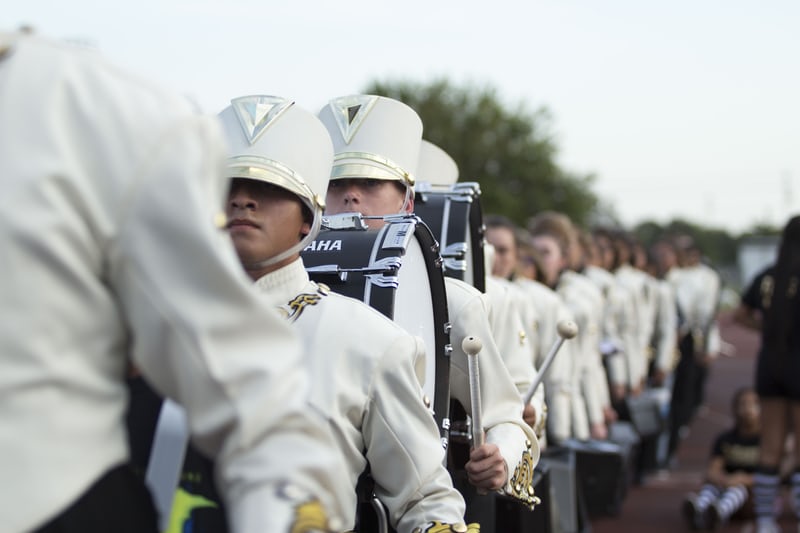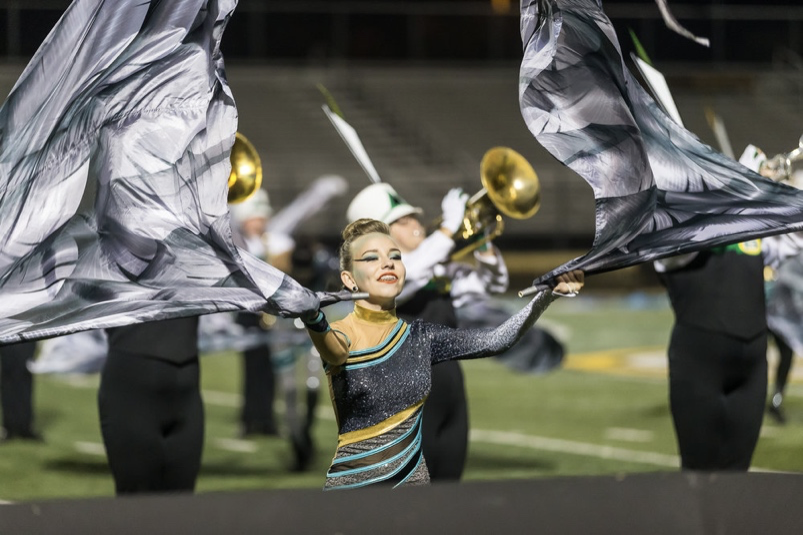
Today you are going to see some great marching bands! The students and instructors have worked countless hours rehearsing music, practicing the marching formations and routines, and perfecting their show to entertain you as they strive to achieve the title of Champion. As you watch these shows, it may interest you to know how marching bands came to be so popular and competitive.
Definition of Marching Bands
A marching band is a group of instrumentalists whose typical instrumentation is comprised of woodwinds (with the exception of oboes and bassoons), brass, and percussion instruments. It combines movement with the musical performance, most often some type of marching. Marching bands are noted for their matching or coordinated uniforms and their performance in parades, halftime shows at football games, and marching band festivals and competitions.
Ancient History
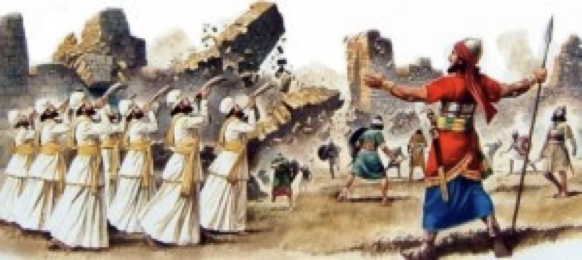
Since ancient times, percussion and wind instruments were used on the battlefields to be an audible command to the troops of the general’s unfolding battle plan. Each military band would have a fanfare to call the soldiers to formation and arms, another fanfare and percussion cadence to declare to the soldiers to advance on their enemy, and still another short fanfare and a rhythmic musical strain for the soldiers to charge the lines of the enemy. Specific musical strains instructed the end units to flank inward to surround the enemy, and a repeated musical strain with a dominant percussion cadence indicated from the commander’s viewpoint the soldiers were winning the battle. As this musical strain was repeated with degrees of faster tempos, it indicated to the soldiers the stages of the battle. When the commander knew that the enemy was invadable the victory strain would be played indicating to the soldiers to rapidly kill all their remaining enemy troops or force the surrender and secure the prisoners of war. This was followed by another victory fanfare where the winning army stood at attention, faced their commander, their battle flag was brought front and center, and the opposing army’s battle flag was set fire in the middle of the winning army’s troops. This victory fanfare is followed by the majestic victory strain or victory chorus in which the soldiers sang the victory lyrics to the chorus and marched off the battlefield with the spoils of war. Both armies had their own band and each band played command music specifically identified with their army. For the losing army, there was a retreat musical strain. It was important for each army to hear the musical commands of their commander as most often the bands were both playing at the same time, so size of band and volume were also considered a part of battle planning. Many times, the band would march closer to, and even into, the battlefield so the musical commands could be heard and understood by the soldiers. Note that the convergence of sounds from these two opposing bands is where we get the concept “Battle of the Bands.”
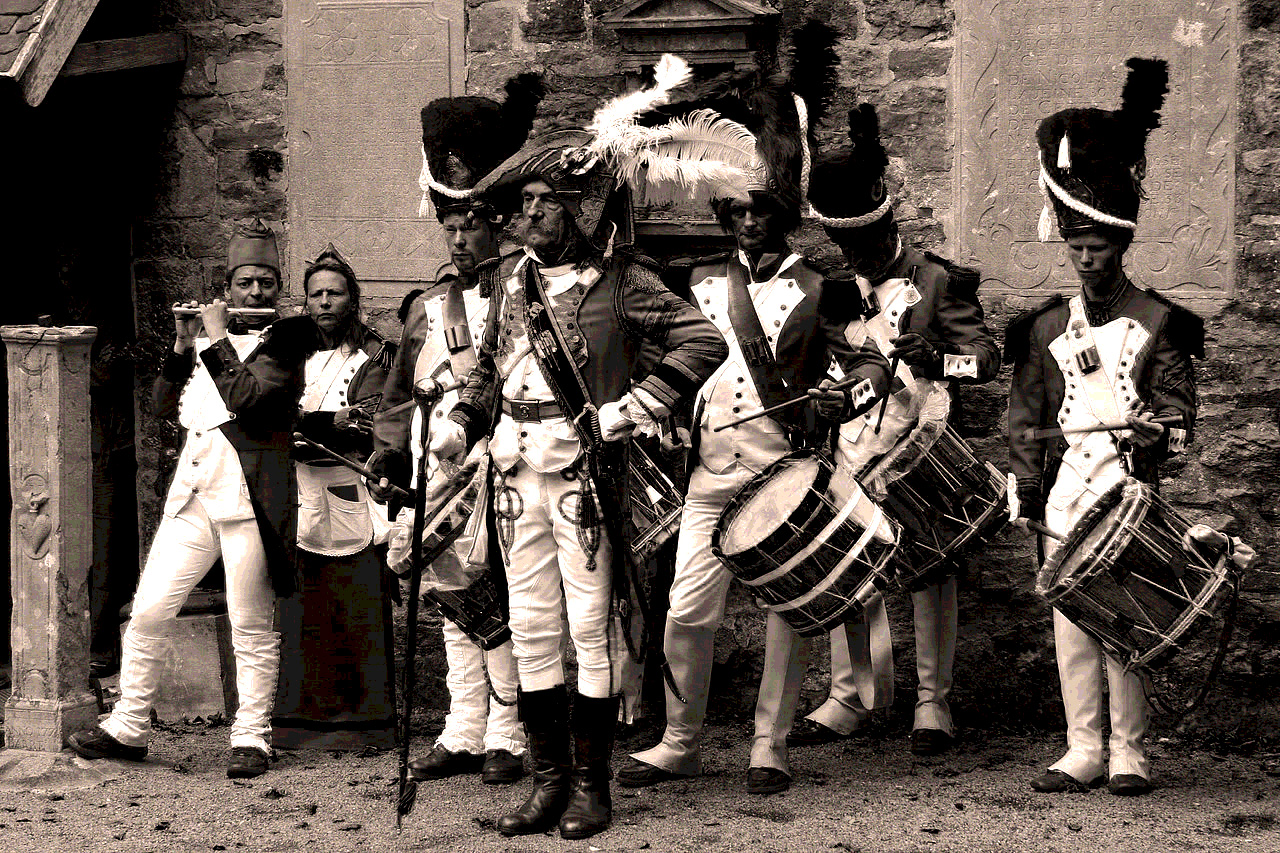
By the 1700s, each regiment in the British Army maintained a military band. Until 1749 British bandsmen were civilian musicians hired at the expense of the regiment’s commanding colonel, making this the first evidence of contracted musicians. But in November of 1749, bandsmen became enlisted men with all the benefits befitting a soldier. Their duty was to not only provide battlefield music but also morale enhancing music, religious service music, and especially Christmas music. When the American colonies went to war with the British army, the colonists did not have the luxury of varied brass and percussion instruments, so the colonists formed fife and drum corps to facilitate the same functions the British military bands provided. Following the colonists’ victory over the British army, fife and drum corps sprung up in almost every town and hamlet throughout the thirteen colonies.
By the early 1800s, the musicians became less important in directing troops’ movements on the battlefield, and these military bands moved into ceremonial roles.
Marching Bands Established in America

On July 11, 1798, an Act of Congress passed approving the purchase of military band instruments from the French and established the United States Marine Band. This Act of Congress established the mission of this military musical organization to provide music for the President of the United States and the Commandant of the Marine Corps. President John Adams invited the Marine Band to make its White House debut on New Year’s Day, 1801, in the then-unfinished Executive Mansion. In March of that year, the band performed for Thomas Jefferson’s inauguration and has performed for every presidential inaugural since. An accomplished musician himself, Jefferson recognized the unique relationship between the band and the Chief Executive and has been credited with giving the Marine Band its title, “The President’s Own.”
Marching Bands Start in American Schools
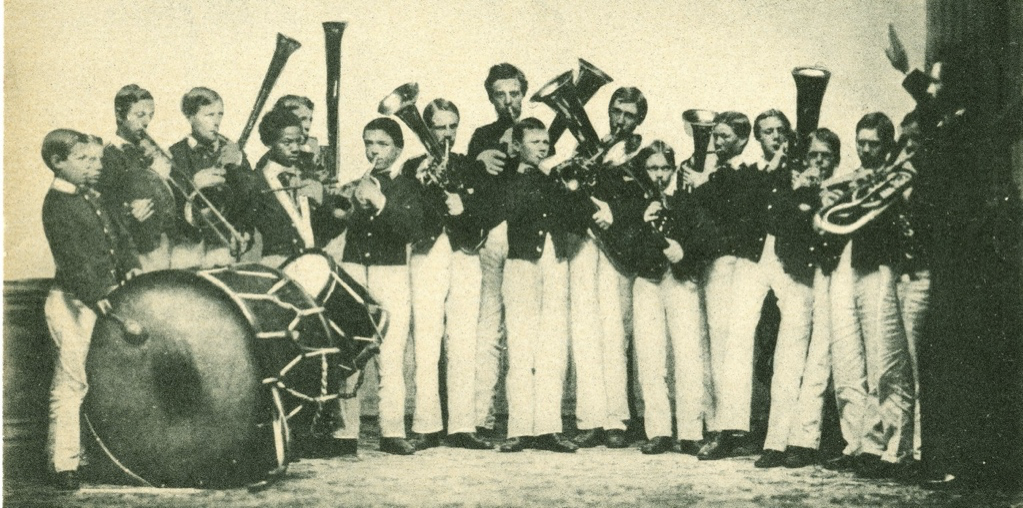
In the summer of 1857, the superintendent of the Boston Farm School, a year-round boarding school for orphan boys on Thompson Island in the Boston Harbor, believed that these boys would fare better when they enlisted in the military if they had a unique talent and could be military musicians. He purchased instruments and uniforms and established a band with around 70 members, which was over half of the student body. An aspiring trumpet player who played substitute trumpet for the Boston Symphony was hired as the full-time band director, and members of the Boston Symphony traveled to the island twice a month to teach private lessons. Band members were in band class two times a day. They attended separate classes in the morning based on the family of instruments and then met collectively at the end of the academic day with full instrumentation where they played symphonic and military selections. They also practiced marching formations for street parades. They performed annual fundraising concerts in Boston at Faneuil Hall and performed in every parade the city offered. The Boston Farm School changed its name in 1956 to the Thompson Academy and closed its doors in 1975. In its 118-year history, more than 2,000 boys learned to play an instrument there. Many went on to perform in US military bands, some pursued degrees in music education or performance, and 22 eventually became members of the Boston Symphony.
Marching Bands Partnership with American Football
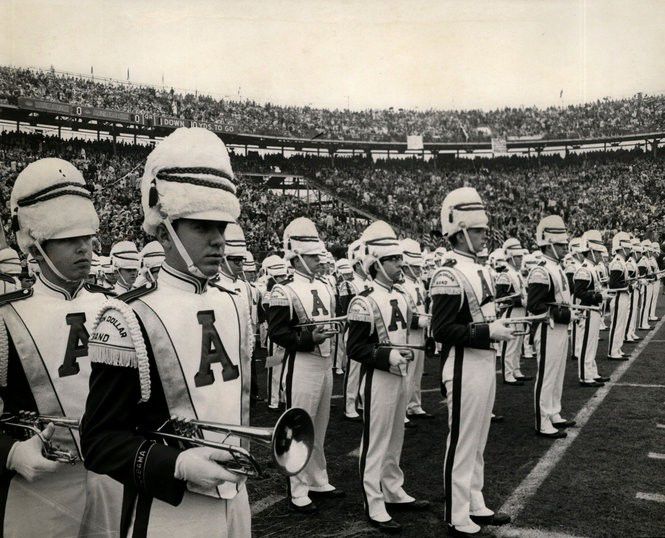
In the United States, modern marching bands are most commonly associated with performing during football games. The oldest American college marching band, the University of Notre Dame Band of the Fighting Irish, was founded in 1845 and first performed at a football game in 1887. Many American universities had marching bands before the twentieth century and were typically associated with military ROTC programs before they were ever associated with the music departments of that university. In 1907, breaking from the traditional rank and file marching on a football field, the first pictorial formation known as the Block P was created by Paul Spotts Emrick, director of the Purdue All-American Marching Band. The first halftime show at an American football game was performed by the University of Illinois Marching Illini, also in 1907.
Marching Bands and War Times
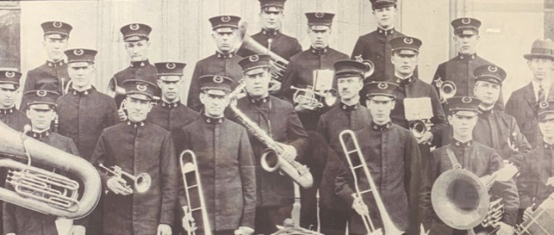
Military bands and their music became highly visible during the First World War. Americans associated them with success in the war effort. Many high schools and colleges started ROTC bands. And many of these either remained after the war or became regular school bands.
Marching Bands Influenced by Popular Music
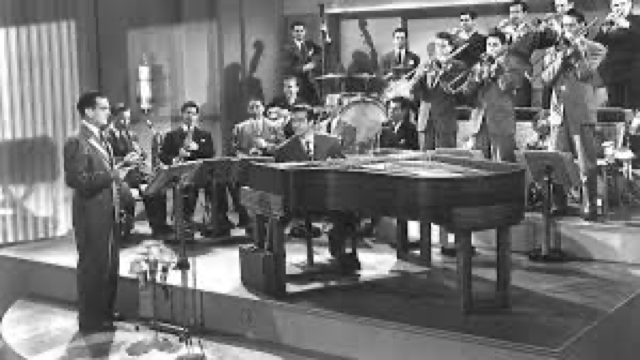
With a booming economy during the 1920s, more musical instruments became available. Immigration increased the population by millions of people. More Americans than before attended high school, and more of them represented the swelling middle class. High schools extended a year from graduating in the 10th grade to graduating in the 11th grade. With the new concept of offering elective classes, music classes were, by far, the most popular, which benefitted school bands.
At the same time, new technology in the form of radio, phonograph records, and motion pictures transformed how Americans spent leisure time. The growing numbers of automobiles made Americans more mobile than ever before. And these automobiles had radios, with stations across the country broadcasting a new kind of popular music called jazz. This sound was being produced by Big Bands, starting with Paul Whiteman and his wind orchestra in 1921. Then the following bands became household names: the Duke Ellington Band, the Red Nichol’s Band, Bix Beiderbecke’s Dixieland Band, The Benny Goodman Band, and the most famous The Glenn Miller Band.
All these factors heightened the desire to participate in the school band program.
It was not until the 1920s that college and university marching bands became common to music departments on college campuses. The increased number of elective courses offered in the progressive education movement also increased the need for music teachers. As a result, many liberal arts and state-sponsored colleges and universities added an instrumental music education major to their degree offerings. The college marching band experience that these instrumental music majors experienced became the model they would take to their high school classrooms. And since college marching bands have become competitive among themselves for innovative formations and crowd-engaging sounds, it only seemed natural that high school marching band would become a competitive activity.
Marching Band Contests Begin
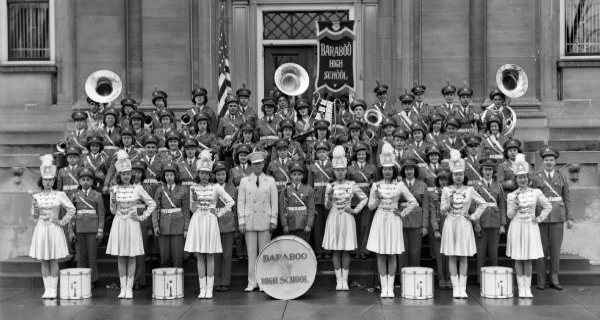
In 1923, the first national band competition for schools was held in Chicago, Illinois, as a means to promote instrumental music in the schools and build a relationship between instrument manufacturers and school music programs. The organizers and sponsors of this contest were the National Music Supervisors Conference and the Band Instrument Manufacturers’ Association. The intent was to encourage greater interest in music in schools by highlighting the most outstanding instrumental music programs in American high schools, thereby increasing the need for more instruments. Thirty schools, mainly from the Midwest, attended this contest which was held under the moniker The National School Band Contest. The competition was held June 3-7 and included a concert band festival, a parade competition, a standard marching maneuver competition, and a marching field show. The winner of each division received a cash prize of $1,000 with additional cash prizes given to most of the other bands. The overall champion band was from Fostoria Senior High School in Fostoria, Ohio.
Following the 1923 competition, the Music Supervisors National Conference, as an organization, decided to begin a “grassroots” foundation by starting competitions at the state level. The decision was made that there would not be a national band competition until bands were performing at an acceptable level to appear at the national level. The Music Supervisors National Conference sought to enhance the state competitions by placing greater emphasis on the educational value by attempting to raise the standard of music performed. This led to the creation of lists of recommended music repertoire. This committee also created guidelines for the adjudication of the state contests. The performance evaluation criteria were divided into four categories including interpretation, tone quality, intonation, and precision.

In 1924, thirteen states held band competitions, but only five adhered to the new rules. In 1925, ten states adopted the new rules, and regional band competitions were held in the East Region and the Mid-West Regions. In 1926, fifteen states conducted official band contests, leading to three regional contests. Also, in 1926, the Music Supervisors National Conference and the National Bureau for the Advancement of Music hosted the national band competition, known as the National School Band Tournament. These organizations oversaw the event held in Fostoria, Ohio, perhaps because Fostoria High School won the first national competition in 1923. Joliet Township High School from Joliet, Illinois, won the championship in 1926. In addition to the competitive portion, the contest finished with a parade of the bands and a mass performance uniting all the participants.
In 1927, 350 bands competed in eighteen state contests for the opportunity to compete at the national competition which was held that year in Council Bluffs, Iowa. 23 bands qualified for the competition. The Music Supervisors National Conference made several changes at that year’s competition. They added sightreading to improve general musicianship and decreased the amount of time spent drilling on contest music. The bands were also divided into Class A and Class B based on school size. The top six bands in Class A took part in a finals performance called a “second trial.” Joliet Township High School won the second year in a row, with the home band from Council Bluffs coming in second.

In 1928, there were thirty state school contests throughout the United States, and from those, 27 bands qualified for the national competition in two classes. Different required pieces were chosen based on whether the bands would participate in Class A or Class B. There was also required band instrumentation of 72 players. Other events for the 1928 competition included solo competitions and a time-measured field marching contest. That year’s national competition was held in Joliet, Illinois, and for the third year in a row the Joliet Township High School Band won first place.
In 1929, the national band competition moved to Denver, Colorado as a means to encourage instrumental music education in that state. Since band classifications were based on school enrollments, which were growing rapidly, the contest changed its classification system to four classes of bands. There were thirty-eight state contests in 1929, with 26 bands qualifying and entering the national competition. That year, the competition was greater defined by adding a visual score component. The winner of the Class A level was the band from Senn High School in Chicago, Illinois. The Class B level competition was won by the Michigan Reform School.
The competition event continued in 1930 despite the Great Depression. A total of 934 bands entered forty-two state school band contests. The national competition was held in Flint, Michigan and 44 bands from across the nation competed. Again, this year the Senn High School Band won the competition.
The year 1931 would be the last year a single winner would be declared. The competition was held in Tulsa, Oklahoma with 40 bands competing. Joliet Township High School Band won their class and the overall competition. The competition concluded with a mass band performance conducted by John Philip Sousa.

In the winter of 1932, the Music Supervisors National Conference held an emergency meeting in Chicago because there was a dramatic decline in registrations for the National School Band Contest later that year. Those attending the special called meeting shared that the issue of traveling to a central location for a contest was proving to be an insurmountable expense the majority of high school bands could not afford due to the effects of the Great Depression. Another factor was that many band programs resented the fact that only one band was declared the winner, resulting in all the other bands feeling like failures and losers. It was decided at this meeting that at the coming event each band would be rated in a festival grading system from I to V. I would be a Superior Rating, II an Excellent Rating, III a Good Rating, IV a Fair Rating, and V a Poor Rating. In addition, based on school size of A, AA, AAA a First Place, Second Place, and Third Place award would be given in each of the school size divisions. However, no overall winner would be declared. This system was in place until 1937 as participation had declined year after year, and when there were less than ten registrations in 1938, the event was canceled.

School district music supervisors soon found that school district administrators, school boards, high school principals, and band directors wanted bands to participate in a competition because winning and placement brought notoriety to the school band program. It also drew additional fans out to the Friday night football games and generated greater support for the overall music programs of the school. Thus, state-sponsored competitions that seemed to have a direct correlation with sports teams winning a state title seemed to make sense to all parties. Soon, many states were offering state marching band contests sponsored by their state band director’s association. Most of the state marching contests offered the festival rating system (I-V) as established in 1932 by the Music Supervisors National Conference, a placement of 1st, 2nd, and 3rd in each school size division, and an overall state champion no matter the school size division.
Ohio and Illinois established their first state marching band competitions in the fall of 1938, Wisconsin in 1939, Indiana and Michigan in 1940, and Florida in 1941. With the beginning of World War II in 1941, and the need for resources on the homefront to be reserved for the war effort, travel was limited, and many male teachers (including young band directors) enlisted or were drafted. Thus, the suspension of these state marching band contests was essential.
Marching Bands and War Times, Again

During World War II the Big Band swing style music was a daily listening staple of the American people. Large patriotic pageantry events were held in municipal stadiums across the United States for the purpose of selling war bonds. These star-studded events almost always had a military marching band marching intricate formations to traditional American marches and military fight songs. This swelling patriotism displayed by these bands gave rise to young people’s desire to be a part of their school’s band programs.
Admittedly, World War II interrupted the growth of school bands, but as was the case of World War I, returning veterans sparked renewed interest and emphasis. Then with the establishment of the G.I. Bill many returning veterans that had been part of one of the militaries performing organizations and/or had played an instrument before the war, entered college as an instrumental music major. By 1952 a whole new group of young band directors were entering the classrooms across America.
Marching Bands and State Marching Band Contests
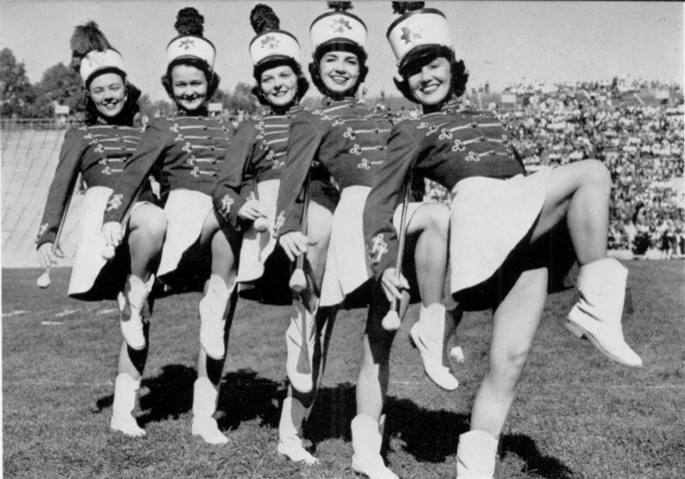
Before state band directors’ associations could be reformed and sponsor state marching band contests, many school districts and large high schools were sponsoring their own marching band contests and festivals. Some colleges and universities sponsored marching contests as a recruitment vehicle for the school. Even state fairs also got into the marching band contest business. In fact, in most states these contests became viewed as practice rounds before the state marching band contest took place. The practice rounds usually began the last Saturday in September and took place every Saturday in October culminating with the state marching band contest on the first or second Saturday in November.
Many states took their first steps towards a state marching contest by establishing regional contests throughout their state in anticipation of a state contest. Texas was at the forefront of this movement by hosting the first regional marching contest on December 14, 1946, in Harlingen, Texas. But it was the South Carolina Band Directors Association that instituted the first state music educators-sponsored state marching contest in 1959, where the eligibility, class divisions, judging procedures, scoring format, and winner categories were established. The first South Carolina Band Director Association-sponsored state marching band contest was held in cooperation with Furman University at Sirrine Stadium on October 24, 1959. This model of establishing and governing a music educator-sponsored state marching contest on the scale that South Carolina initiated became the standard by which other states mirrored their competitions. By the early 1970s, 37 states had established their state marching band contest.
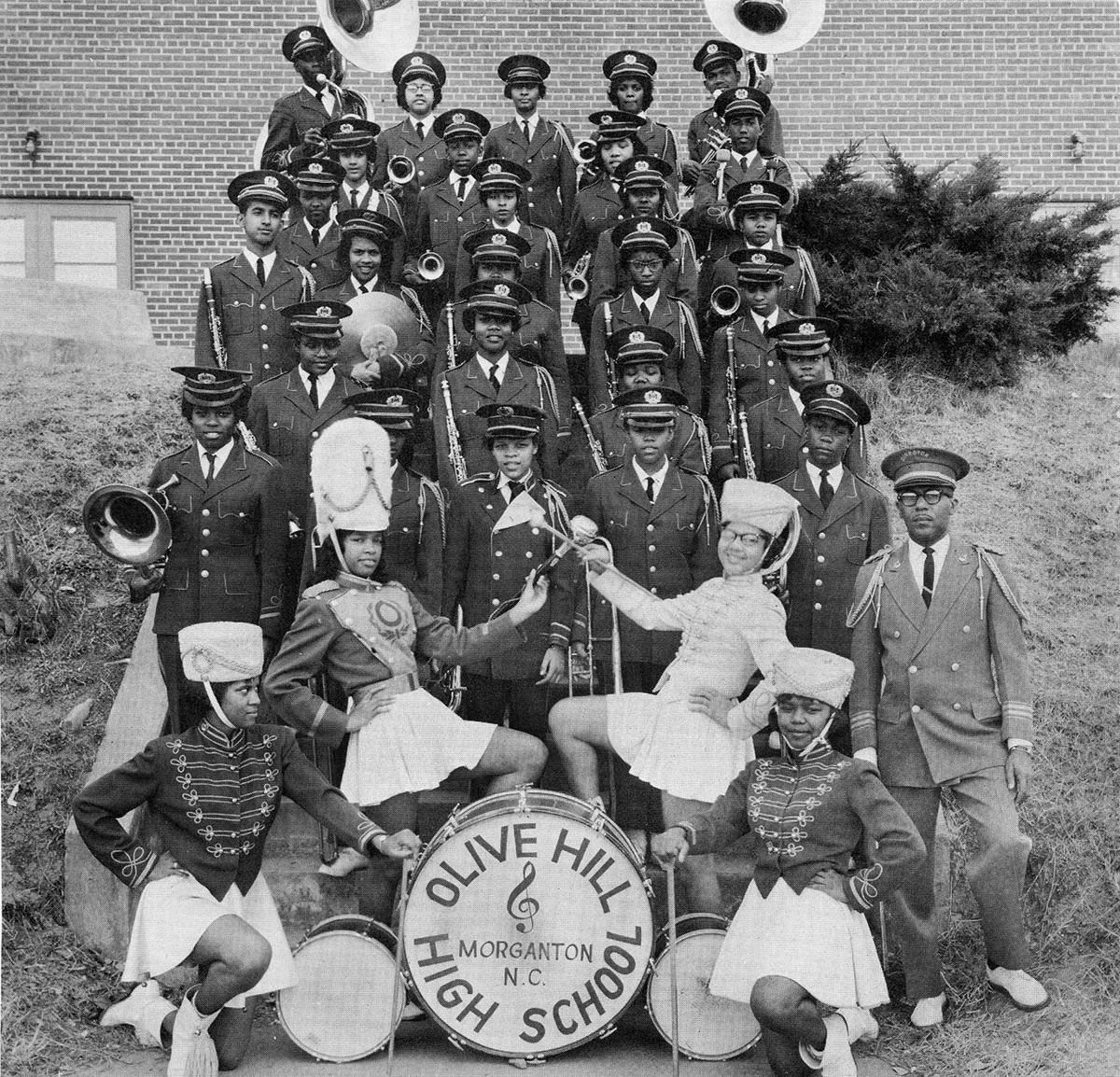
During the Separate But Equal movement of segregated schools starting in the mid 1950s through the late 1960s until integration was fully embraced, African American high schools drew much of their identity from their marching bands. In some states there were separate divisions for African American bands as a part of their overall state marching band competitions. However, in other states the Association of Show Bands was chartered by African American Band Directors and they produced their own marching band contest often in association with a regional historic black college.
Marching Bands Look to Parades to Determine America’s Best Bands

In the 1950s, as state marching band contests were being established, there were great desires among band directors, and especially school district music supervisors, for their bands to be recognized on a national level. Thus, they looked at the two major parades: the Tournament of Roses Parade and Macy’s Thanksgiving Day Parade, which both had major national TV coverage. The Macy’s Parade received national TV coverage in 1948, but it was not until 1954 that the Tournament of Roses Parade began national TV coverage. But when it did, it did so with a bang because it was the first TV show to be in color.
There soon became a battle between these two parades as to which one would get the most outstanding bands in America to appear in their parade. The tables turned in Macy’s favor in 1957 when they started the band showcase revue in front of the VIP Grandstand across the street from the main entrance to Macy’s. Each participating band was allowed 90 seconds to turn to the VIP Grandstands (and the TV cameras) in order to demonstrate a marching maneuver and feature auxiliary units like dance line, majorettes, and/or color guard. This featured exposure fueled band directors across the country to covet a performance slot in the Macy’s parade as an endorsement of their national standing. The band selected to usher in the Santa float at the end of the parade was considered to be the top pick band of all those participating that year. Thus, in an implied manner this band could be considered the best band in American for that year.

The Tournament of Roses Parade was not going to be outdone so in 1961 they touted that they had the largest and best high schools bands in America participating in their parade. But it was not until 1970 that they began a national thirty-minute parade pre-show featuring each of the high school bands performing a parade routine in a parking lot near the beginning of the parade route, with additional footage of the band rehearsing in their hometown. And then in 1972 they began the Tournament of Roses Bandfest which is a three-day marching field show festival. These two events elevated the Tournament of Roses Parade to becoming the king of parades for high school marching bands.
However, the battle of the bands between these two parades changes each year based on the TV coverage time each band will receive. Selection for parade participation still carries considerable weight and bragging rights among marching band directors, their school’s administration, and the hometown community as a whole.
The Influence of Drum Corps on High School Marching Bands

A drum and bugle corps is also a musical marching unit, but it differs from marching bands. Marching bands have woodwinds, brass, percussion, color guards, and often majorette/dance line squads. In contrast, the drum and bugle corps consists of only brass, percussion, electronic instruments, and color guard. Drum and bugle corps are typically operated as independent non-profit organizations, unlike marching bands which are sponsored by school districts and are a part of the curriculum. Following World War I, drum and bugle corps sprung up as auxiliary units to Veterans of Foreign Wars (VFW), the American Legion (AL), and Catholic Youth Services. Each of these organizations established the summer contest season and their own rules, and if corps moved in competing from one system to the next, they had to learn and observe the rules of each system.

Another aspect is that high school marching bands begin rehearsal in early August and complete their performance/contest season by the second week of November. Before the school year begins, bands typically have one or two weeks of band camp that can last up to ten hours a day. When the school year begins in-class and after-school rehearsal time is dictated by the high school administration or the school district administration. Most often the high school band is limited to 10 hours per week of rehearsal. These marching bands compete nine Saturdays in the fall, at the most. In contrast, the drum and bugle corps has three weeks of camp starting the last week of May and start touring nationally the last week of June. During the day, six days a week, they rehearse an average of eight hours a day and compete six nights a week in different cities crisscrossing the United States until they come together the second week of August for their national competition. Membership in the drum and bugle corps is taken from months of national auditions of young people from ages 16 to 21, with most of the marching performers being college-age music majors.
The average high school band has an educational staff of three instrumental music educators, and during the marching season will also employ a drumline instructor and a color guard instructor. However, a drum and bugle corps has an instructional staff of over ten: a high brass instructor, a low brass instructor, a drum line instructor, a pit instructor, and each of these instructors will have two or three assistants. Then the color guard will have three to five instructors. There is an overall corps director, general manager, and logistic support staff that travels with the corps.
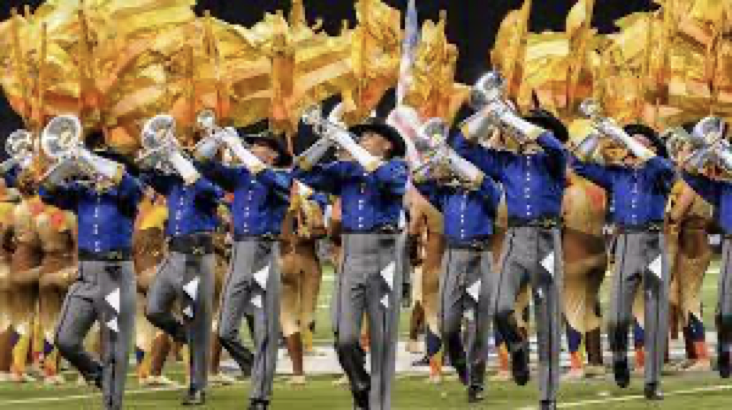
Drum corps have fan followings that last for years, and the corps alumni prove to be very supportive. Moreover, the owners of these corps receive a financial benefit if their corps place in competitions. Initially, each organization had its own payout rules for winning groups; for example, if a winning corps was not a member of the competition-sponsoring organization, they would receive a trophy for placing, but the financial rewards would only go to the corps within their organization or association. Thus, it became imperative that one central organization be created to consolidate the rules and financial benefits to make them achievable and accessible to all corps groups. This ultimately led to the formation of Drum Corps Associates (DCA) in 1965 and Drum Corps International (DCI) in 1972. When DCI secured a national broadcast deal in 1975 with Public Broadcasting Service (PBS) to cover live their national finals, all the major drum corps came under the umbrella of DCI.
That August Sunday afternoon in 1975, what the nation watched coming from Philadelphia was show design and execution very different from the high school bands they were accustomed to seeing at Friday night football games and Saturday marching contests. They witnessed visually complex marching with the corps having developed and formalized various movement techniques with the goal being the achievement of fluid, consistent movements that allowed for precise musical technique at all tempos, step sizes, and directions. The repertoire revolved around one genre of music, or sometimes separate genres together. That performance was filled with classical symphonic works, jazz, Broadway, pop, and rock music. A new age of marching band music and marching technique was ushered into the living rooms of Americans. High school band directors paid special attention to this new concept and were soon employing the drum and bugle corps concepts in their marching shows.
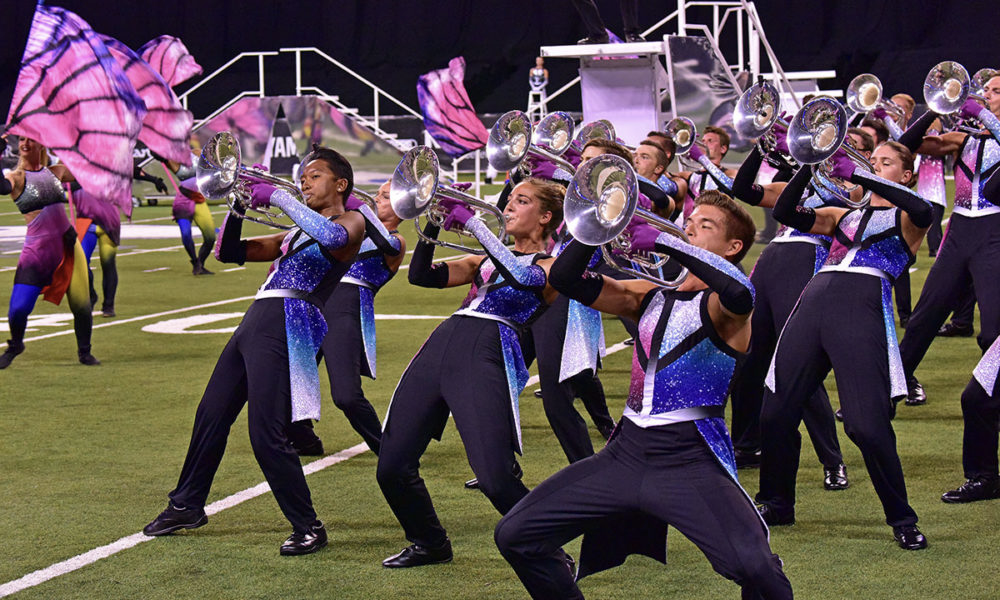
Since that first telecast in 1975, the relationship between drum and bugle corps and high school marching bands soon became a marriage. The drum and bugle corps for the most part have more financial means, larger staff, more rehearsal time, and nationally selected corps members. The combination of these four components allows for the creative conceptional ideas and the time to experiment with these ideas and provides the means to pay for the realization of these creative concepts. The drum and bugle corps have become the conceptional creators that high school marching band shows are emulating.
High school marching bands to this point in time were judged on marching precision, musical expression, and technical accuracy. However, when corps style became the main stylistic approach to the high school marching show the judging rubric changed to some variation of the following: musical analysis, marching/visual proficiency, general effect visually, general effect musically, and overall general effect. With this change, high school bands embraced the importance of the color guard, majorettes, and the dance line, but by far it was the color guard that received the most attention. Unlike the drum and bugle corps that had a set number of color guard members, high school bands could have as many color guard members as they desired on the field. Some large high school bands have as many as 120 color guard members using multiple flags, rifles, sabers, and almost anything that can be spun, twirled, or draped. And large-scale sets and back drops have been added as a show element with the goal of increasing the general effect score.

Today, many high school marching band directors have had some connection to the drum and bugle corps world. They may have been a corps member while in high school or college, they may have served (or still be serving) on the staff of one of the corps, and/or they have immersed themselves in training clinics sponsored by DCI. The college or university they attended may host the staff of a drum and bugle corps, who may also serve as marching band instructors on their campus. Whatever the connection, the concepts introduced by the drum corps have become widely accepted and implemented by high school band directors across the United States.
The Changing Look of the High School Band
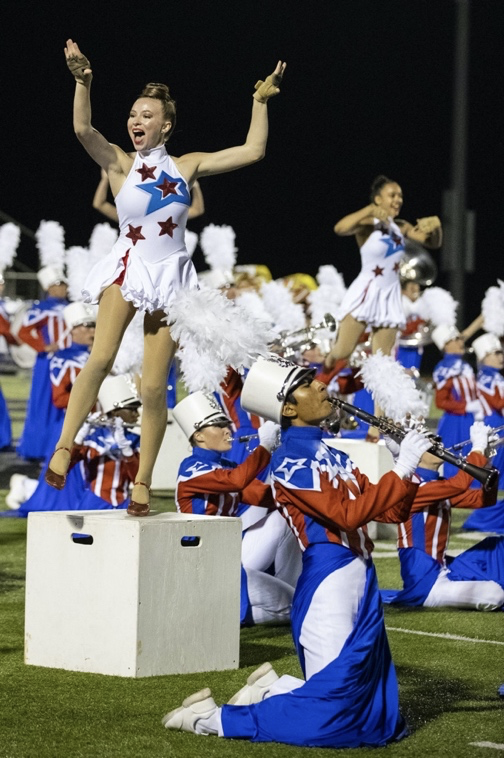
Following World War II, the majority of high school band uniforms were fashioned after one of the dress uniforms of the US Military. These uniforms were almost always in the school colors. When integration happened in the 1960’s most public schools were faced with combining the school colors from the white school and the African American school. Most often, the African American schools had black as one of their colors. Thus, black became one of the school colors in the majority of schools across America. This meant the purchasing of new uniforms to reflect these colors. When these uniforms were purchased by the school district, they were intended to have a shelf-life of 20 years. These uniforms were expensive, primarily made of wool, and had to be dry cleaned. Then in 1994, one of the major band uniform manufacturers designed a machine washable uniform. This uniform came at a much lower price point. This allowed the marching band show designer to give consideration of the uniform as a design element in coordination with the overall theme of the show. So, school colors were abandoned for colors and design that would enhance the overall show’s general effect. With the cost being considerably less, many bands have uniform changes as often as every year so the uniform design can be coordinated with that year’s show concept.
National High School Marching Band Competition/Championship Emerges
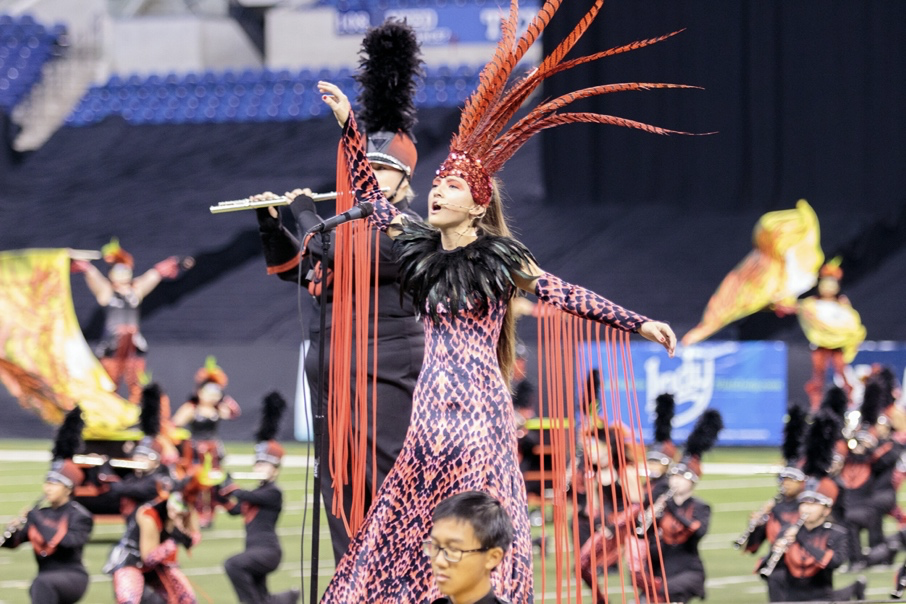
Seeing the strong fan support and financial success of DCI, music education supply company entrepreneur Larry McCormick established Marching Bands of America in 1975 as another option for high school bands to the DCI model. Hoping for the same overwhelming success of DCI, Mr. McCormick invested in hosting the first annual high school marching band festival on the campus of the University of Wisconsin-Whitewater in the summer of 1976. His plans included the festival concluding with the first Grand National Championship high school marching band contest. In reality, Mr. McCormick was re-establishing a national high school marching band championship contest.
Larry McCormick made the right call because Marching Bands of America’s first national marching band festival and contest was a tremendous success in the summer of 1976. 32 bands participated in this first Marching Bands of America Grand National Championship. There were two divisions for the bands to compete in that year: the A Class was for bands who came from high schools with less than 600 students and the Open Class for bands from high schools of more than 600 students. The Grand National Champion could come from either class. The inaugural year, the winner of the A Class was Kosciusko High School Band from Kosciusko, Mississippi and the winner of the Open Class was Live Oak High School Band from Morgan Hill, California. The first Grand National Champion was the Live Oak High School Band.
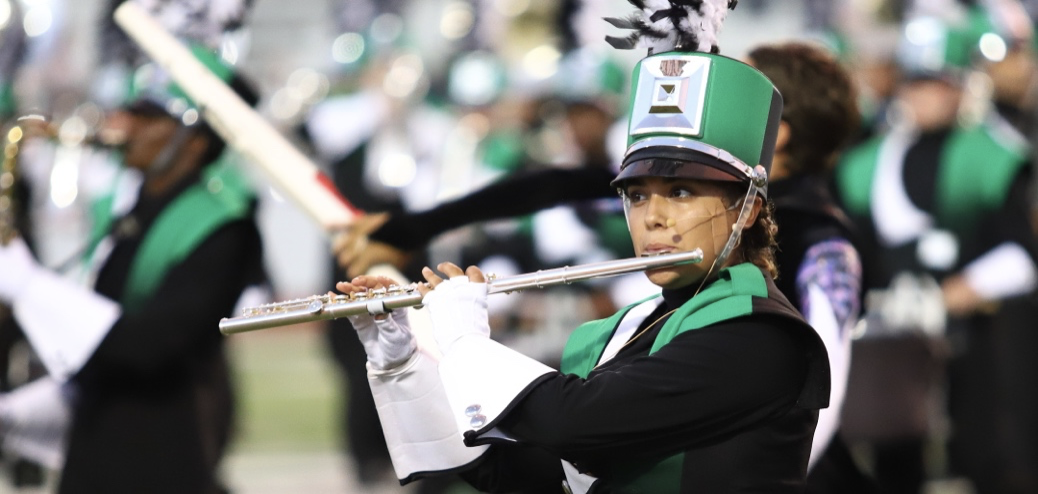
It had been 45 years since a national high school band champion had been crowned. This event proved to be the catalyst for a judging process and stylistic presentation format that would take hold for bands and the myriad of marching contests across America. This first year not only were the stands filled with fans supporting their competing bands, but also with band directors and school district music supervisors from across the country. They immediately began envisioning their bands competing in this contest and coming home with the Grand National Championship Trophy along with all the prestige this title would bring. Soon they were adopting the Marching Bands of America adjudication format and contest procedures into their local, district, and state marching band contests in preparation for their own participation at the national level.
The Marching Bands of America marching contest was held in June from 1976 to 1979. Since 1980, the Grand National Championship has been held in November to fit into the traditional high school football season schedule and the correlating local and state marching band contests. Marching Bands of America was spun-off as an independent entity by McCormick Enterprise’s, beginning in 1983, and was incorporated as Bands of America, Inc in 1984. In 1988, Bands of America was awarded tax-exempt status and formed a Board of Directors to oversee the operations of the organization and to see that its mission is fully realized.
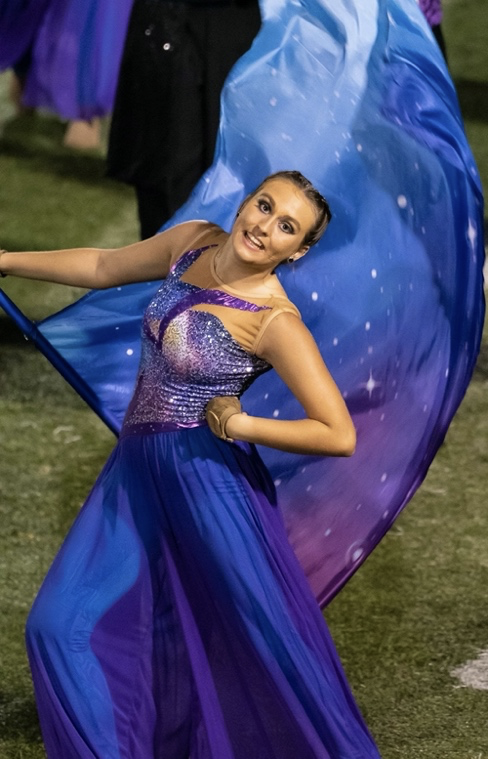
In 1978, the organization began hosting regional competitions across America and in 2004 the Super Regional contest began. Since its inception in 1976 more than 10,000 high school bands have competed representing 2.1 million participating music students. Approximately 470,000 spectators attend Bands of America contests each year resulting in an estimated 10.6 million spectators in the past 45 years. Bands of America has well established itself, and the winner of the Grand National Championship is without question considered America’s best high school marching band for that year. (Winners of the Bands of America Grand National Championship)
Another organization emerged in 1988 to also create a high school marching band contest system that could also award a National Champion. This organization was United States Scholastic Band Association (USSBA) and a few years later changed their name to USBands. USBands came directly from the DCI Pennsylvania-based The Cadets Drum and Bugle Corps as a fund rising source for this DCI corps. In October of that year, The Cadets Drum and Bugle Corps hosted the first US Bands Open National Champions at Giants Stadium in East Rutherford, New Jersey where the Open Class contest has been held ever since. The winner of the Open Class at this event is esteemed as the National Champions. The organization sponsors more than 80 marching band events across the nation each fall. Most of these events are held in the Northeast, and Texas, with the National Champion historically coming from the Northeast.
Although, USBands is a positive influence on the lives of the high school band members that participate in their events, it is the Bands of America Grand National Champion that is considered the true National Champion of high school marching bands across America.
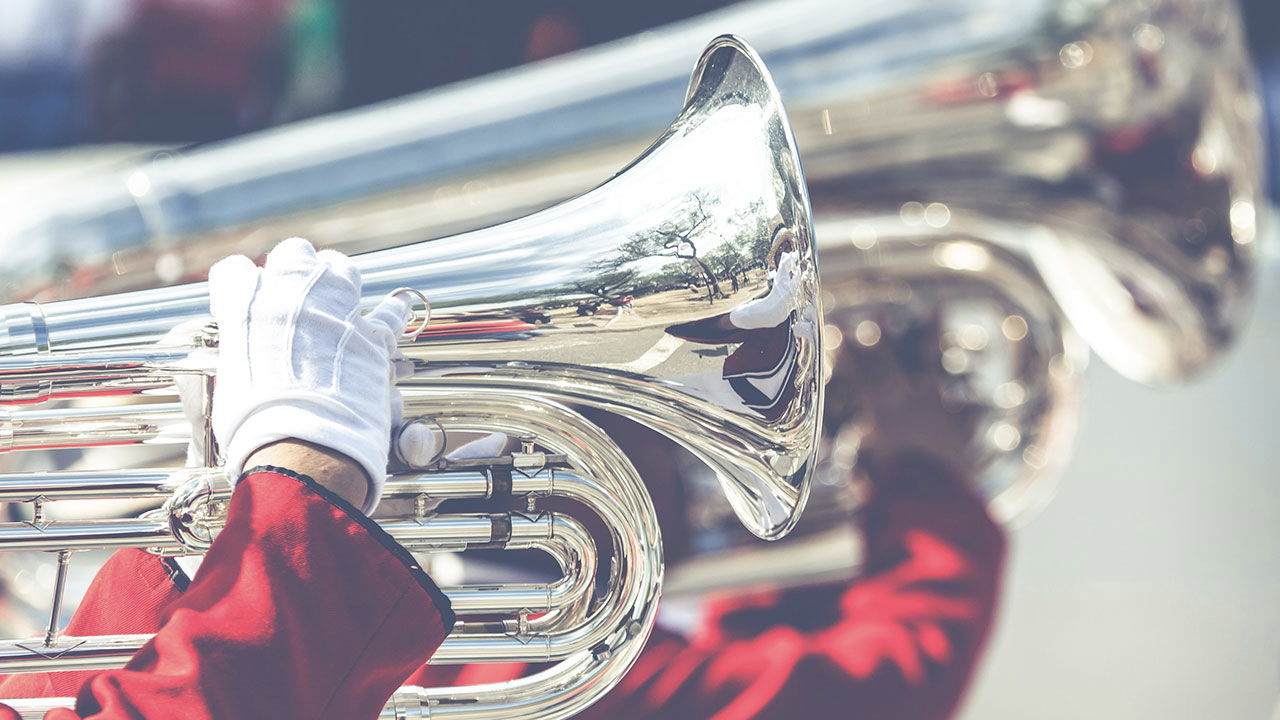
Student participation in high school marching bands across America has seen an increase each year since the first national high school marching band contest held in 1923. High school marching bands have become a vital part of the fall fabric of high school and college football. And bringing home the trophy is the goal for high school bands in every community whether it is at the local school district level, the state district level, the state level, or the national level. As a whole, people love a marching band, especially the marching band from their city, town, or community. Yes, a high school marching band is very much a part of the overall American culture.
